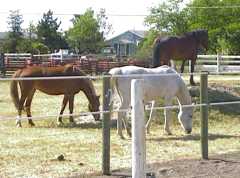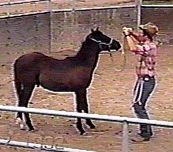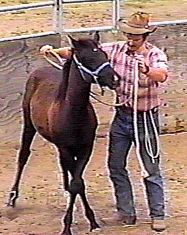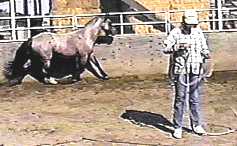|
Ground schooling is one of the most misunderstood elements of horse
handling. People often ask, "Why do I need to ground school my
horse? I don't want to tire him out. I want to ride him."
Yet these same folks are often complaining that their horse is hard
to start, hard to stop, won't respond to aids and so forth.
Ground schooling is not only effective, but a necessary
tool that the competent horseman applies to keep his horse tuned up
and operating properly.
|
Establish the Chain of Command
As herd animals, horses need a chain of command. The
very fabric of herd social activity and survival is based on
who's the boss. Therefore it becomes disconcerting to a horse
to be forced into an environment where there is no clear leader
and oftentimes when he doesn't perceive a leader, the horse's
natural instinct is to take charge.
|
Every herd, no matter what size
must have a leader / protector

|
|
Establish Communication
The handler and the horse must be able to communicate with each
other. This means that each animal must be able to read the
other's intentions, directions and emotions. It's usually not
enough for the rider or handler to dictate to the horse unless he's
going to be satisfied with the most menial of results. Communication
can best be developed on the ground where both the horse and handler
can most effectively see and relate to each other.
|
Communication is a
two way process

|
|
Define the Handler's Space
Space is a critical issue for a horse. It is that invisible
bubble which surrounds a horse which is somewhat sacred. A
subordinate horse does not invade a superior's space without
an invitation. Establishing one's space is important for
several reasons. First, you don't want to get run into or
stepped on if the horse gets startled or distracted. Secondly
a horse considers it to be an honor to be invited into a
superior's space. You must have that space defined for these
things to work.
|
Even youngsters have to
learn where the handler's
space begins.

|
|
Develop Yielding to Pressure
Just about everything a horse is going to do under saddle involves
yielding to pressure. Whether it's responding to leg pressure or
rein contact, a responsive horse is moving in response to the rider's
pressure. You want a light handling horse? Establish the proper
response to pressure on the ground where you have the greatest control
over the learning environment, then apply those principles in the saddle.
|
The horse must yield to
direct and indirect pressure

|
|
Develop Stress Handling
Before you get in the saddle you need to know how your horse is going to
react under stress, and your horse needs to be able to handle stressful
situations and still pay attention to your aids and cues. Ground schooling
should include "pushing the envelope" in a controlled environment so that
the horse will learn to look to the handler for direction in unusual,
unsettling and/or fast moving situations. This is much better handled on
the ground than atop the horse.
|
The horse needs to
work things out in a
safe, controlled environment

|
|
Develop Transitions
The horse needs to be able to reliably increase or decrease
speed, stop and reverse with minimal pressure. These
transitions usually start out clumsily, but with practice
and attentiveness by both horse and handler, transitions
can become second nature. Developing a good response on
the ground will provide a sound basis for lightness and
responsiveness in the saddle.
With the transitions working well, you can ask the horse to
adjust his weight for improved lateral work.
|
Even this 18 mo. old
draft filly could move
handily under saddle

|
We hope to have brought home the point that ground schooling
isn't just sending the horse around in circles. It's a safe
and sane preparation for more advanced work in the saddle and
for bomb proofing.
The elements of effective ground schooling are presented in the
various features in the
training section.
|
Important Note: If you take on the project of
developing an untrained horse, everybody will want to give you advice.
Don't act on any advice, including the ideas offered in this site,
unless it makes sense to you and fits your individual situation. Your
abilities and the sensitivities of your horse(s) may differ from the
examples given. Be alert and rational with your actions so neither you nor
your horse will get hurt. This information is offered as illustrations of
what we do and the reader must apply common sense since he or she is solely
responsible for his or her actions.
Happy trails!
Press "Back" to return to the page that brought you here
KBR Horse Training Information, © 1997
Lamm's Kickin' Back Ranch and Willis & Sharon Lamm. All rights reserved. Duplication of any of
this material for commercial use is prohibited without express written permission.
This prohibition is not intended to extend to personal non-commercial use, including sharing
with others for safety and learning purposes, provided this copyright notice is
attached.
Email us to submit comments or
request reproduction permission.
|






